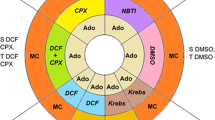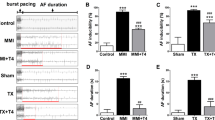Summary
It is generally believed that the increased contractility and tachycardia of the hyperthyroid heart are a result of thyroid hormone-induced alterations of the mechanical and electrical properties of the heart, respectively. We compared the contractility (dP/dtmax) and the spontaneous beating rate of hyperthyroid and euthyroid hearts perfused in vitro in either a non-working or a working mode. The dP/dtmax (4196±74 mm Hg s−1) and beating rate (322±8 beats/min) of the non-working hyperthyroid hearts were significantly higher (p<0.001) than those of the euthyroid hearts (3267±115 mm Hg s−1 and 260±6 beats/min at an external Ca2+ of 2.5 mM). At 2.5 mM Ca2+, the working hyperthyroid hearts again displayed enhanced contractility (5636±179 mm Hg s−1 vs 4508±172 mm Hg s−1; p<0.001) but the spontaneous beating rate (275±7 beats/min) was not significantly different from euthyroid (261±8 beats/min). When hearts were subjected to periods of alternate non-working and working perfusion, the beating rate of the hyperthyroid hearts was significantly higher than euthyroid during non-working (p<0.02) but not during working perfusion. Increasing the afterload on the non-working preparations in a stepwise fashion from 75 cm H2O to 120 cm H2O caused significant changes in left ventricular pressure and dP/dtmax in both heart types but the tachycardia in the hyperthyroid hearts persisted (at 120 cm H2O; hyperthyroid, 294±9 beats/min; euthyroid, 224±10 beats/min; p<0.001). Alteration of the preload (10 to 25 cm H2O) and afterload (75 to 105 cm H2O) on working hyperthyroid and euthyroid hearts caused changes in both left ventricular pressure and dP/dtmax but the beating rates of both heart types were never significantly different. We conclude from our results that (i) the increased contractility of the hyperthyroid rat heart is due to thyroid hormone-induced alteration of the mechanical properties of the heart; (ii) the tachycardia of hyperthyroidism is not due to thyroid hormone-induced changes in the electrical properties of the heart, but probably involves some as yet unidentified chronotropic agent.
Similar content being viewed by others
References
Anthonisen P, Holst E, Thomsen AAC (1960) Determination of cardiac output and other haemodynamic data in patients with hyper- and hypothyroidism using dye dilution technique. Scan J Clin Lab Invest 12:472–480
Brewster WR Jr, Isaacs JP, Osgood PF, King TL (1956) The haemodynamic and metabolic interrelationships in the activity of epinephrine, norepinephrine and the thyroid hormones. Circ 7:1–20
Brooks I, Flynn SB, Owen DAA, Underwood AH (1985) Changes in cardiac function following administration of thyroid hormones in thyroidectomised rats: assessment using the isolated working heart preparation. J Cardiovasc Pharmacol 7:290–296
Brus R, Hess ME, Jacobowitz D (1970) Effect of 6-hydroxydopamine and thyroxine on chronotropic response to norepinephrine. Eur J Pharmacol 10:323–327
Buccino RA, Spann JF, Pool PE, Sonnenblick EH, Braunwald E (1967) Influence of the thyroid state on the intrinsic contractile properties and energy stores of the myocardium. J Clin Invest 46:1669–1682
Chizzonite RA, Zak R (1984) Regulation of myosin isozyme composition in fetal and neonatal rat ventricle by endogenous thyroid hormones. J Biol Chem 25:12628–12632
Coville PF, Telford JM (1970) Influence of thyroid hormones on the sensitivity of cardiac and smooth muscle to biogenic amines and other drugs. Br J Pharmacol 39:49–68
Cravey GM, Gravenstein JS (1965) The effect of thyroxin, corticosteroids and epinephrine on atrial rate. J Pharmacol Exp Ther 148:75–79
Dillmann WH (1984) Hormonal influences on cardiac myosin ATPase activity and myosin isozyme distribution. Mol Cell Endocrinol 34:169–181
Flink IL, Morkin E (1977) Evidence for a new cardiac myosin species in thyroxic rabbit. FEBS Lett 81:391–394
Goldman S, Olajos M, Friedman H, Roeske WR, Morkin E (1982) Left ventricular performance in conscious thyrotoxic calves. Am J Physiol 242:H113-H121
Goodkind MJ (1966) The influence of thyroid hormone on myocardial metabolism of norepinephrine in the guinea pig. J Pharmacol Exp Ther 154:531–538
Goodkind MJ, Dambach GE, Thyrum PT, Luchi RJ (1974) Effects of thyroxine on ventricular myocardial contractility and ATPase activity in guinea pigs. Am J Physiol 226:66–72
Gunning JF, Harrison CE Jr, Coleman HN III (1974) Myocardial contractility and energetics following treatment with d-thyroxine. Am J Physiol 226:1166–1171
Hess ME, Reynolds KA, Frazer A, Viscusi D (1980) Inhibitory effects of desmethylimipramine on cardiac beta-receptors and myocardial phosphorylase. J Cardiovasc Pharmacol 2:867–879
Hirvonen L, Lybeck H (1956) Methanogram observations on the isolated auricle of hypothyroid rat. Acta Physiol Scand 36:29–37
Hirvonen L, Paaivilainen TOA (1967) Response of rat atrium to propranolol and catecholamines in various states of euthyroid function. Acta Physiol Scand 69:284–294
Hoh J, McGrath P, Hale P (1977) Electrophoretic analysis of multiple forms of rat cardiac myosin: Effects of hypophysectomy and thyroid replacement. J Mol Cell Cardiol 10:1053–1076
Ishac EJN, Pennefather JN, Handberg GM (1983) Effect of changes in thyroid state on atrial α- and β-adrenoceptors, adenylate cyclase activity and catecholamine levels in the rat. J Cardiovasc Pharmacol 5:396–405
Kim D, Smith JW (1985) Effects of thyroid hormone on calcium handling in cultured chick ventricular cells. J Physiol 364:131–149
Krebs HA, Henseleit K (1932) Untersuchungen über die Harnstoffbildung im Tierkörper. Hoppe-Seylers Z Physiol Chem 210:33–66
Kurland GS, Hammond RP, Freedberg AS (1963) Relation of thyroid state to myocardial catecholamine concentration. Am J Physiol 205:1270–1274
Langendorff O (1895) Untersuchungen am überlebenden Säugetierherzen. Pfluegers Arch Ges Physiol Menschen Tiere 61:291–332
Lee WC, Lee CY, Yoo CS (1965) Effects of treatment with thyroxine on the noradrenaline content of the rabbit heart. Br J Pharmacol 25:651–657
Levey GS, Skelton CL, Epstein SE (1969) Influence of hyperthyroidism on the effects of norepinephrine on myocardial adenyl cyclase activity and contractile state. Endocrinol 85:1004–1009
Lewis JK, McEachern D (1931) Persistence of an accelerated rate in the isolated hearts and auricles of thyroxinized rabbits: response to iodides, thyroxine and epinephrine. Bull Johns Hopkins 48:228–241
Limas CJ (1978) Enhanced phosphorylation of myocardial sarcoplasmic reticulum in experimental hyperthyroidism. Am J Physiol 234:H426-H431
Marcus RH, Nijland MJM (1986) Problems with the Krebs-Henseleit bicarbonate buffer in Johannesburg. S A J Sci 82:223
Marcus RH, Butkow N, Wheatley AM, Lippe I, Norton G, Rosendorff C (1987) Independent mechanisms for the chronotropic and inotropic responses in hyperthyroidism. Basic Res Cardiol 82:261–270
Marriot ML, McNeill JH (1983) Effect of thyroid hormone treatment on responses of the isolated working rat heart. Can J Physiol Pharmacol 61:1382–1390
Martin AF, Pagani ED, Solaro RJ (1982) Thyroxine-induced redistribution of isozymes of rabbit ventricular myosin. Circ Res 50:117–124
McDonough KH, Chen V, Spitzer JJ (1987) Effect of altered thyroid status on in vitro cardiac performance in rats. Am J Physiol 252:H788-H795
Mendelsohn IE, Bassett A, Kelly JJ, Hoffman BF (1961) Effect of reserpine on tachycardia induced by thyroid in the isolated atrium of the rat. Am J Cardiol 7:694–696
Morkin E, Flink IL, Goldman S (1983) Biochemical and physiological effects of thyroid hormone on cardiac performance. Prog Cardiovasc Dis 25:435–464
Naylor WG, Merrillees NCR, Chipperfield D, Kurtz JB (1971) Influence of hyperthyroidism on the uptake and binding of calcium by cardiac microsomal fractions and on mitochondrial structure. Cardiovasc Res 5:469–482
Neely JR, Liebermeister H, Battersby EJ, Morgan HE (1967) Effect of pressure development on oxygen consumption by isolated rat heart. Am J Physiol 212:804–814
Pannier JL (1968) The influence of thyroid hormone on myocardial contractility. Arch Int Physiol Biochim 76:477–490
Priestley JT, Markowitz J, Mann FC (1931) The tachycardia of experimental hyperthyroidism. Am J Physiol 98:357–362
Sanford CF, Griffin EE, Wildenthal K (1978) Synthesis and degradation of myocardial protein during the development and regression of thyroxine-induced cardiac hypertrophy in rats. Circ Res 43:688–694
Strauer BE, Scherpe A (1975a) Experimental hyperthyroidism I: Haemodynamics and contractility in situ. Basic Res Cardiol 70:115–129
Strauer BE, Scherpe A (1975b) Experimental hyperthyroidism 2: Mechanics of contraction and relaxation of isolated ventricular muscle. Basic Res Cardiol 70:130–141
Suko J (1973) The calcium pump of cardiac sarcoplasmic reticulum. Functional alterations at different levels of thyroid state in rabbits. J Physiol 228:563–582
Taylor RG, Covell JW, Ross J Jr (1969) Influence of the thyroid state on left ventricular tensionvelocity relations in the intact, sedate dog. J Clin Invest 48:775–784
Tazacs IE, Szabo J, Nosztray K, Szentmiklosi AJ, Cseppento A, Szegi J (1985) Alterations of contractility and sarcoplasmic reticulum function of rat heart in experimental hypo- and hyperthyroidism. Gen Physiol Biophys 4:271–278
Thier MD, Gravenstein JS, Hoffman RF (1962) Thyroxin, reserpine, epinephrine and temperature on atrial rate. J Pharmacol Exp Ther 136:133–141
Turner CW, Shenfield GM (1980) The effect of thyroid dysfunction on the chronotropic response to noradrenaline. Eur J Pharmacol 68:295–303
van der Schoot JB, Moran NC (1965) An experimental evaluation of the reputed influence of thyroxine on the cardiovascular effects of catecholamines. J Pharmacol Exp Ther 149:336–345
van Heuningen R, Rijnsburger HW, ter Keurs HEDJ (1982) Sarcomere length control in striated muscle. Am J Physiol 242:H411-H420
Wheatley AM, Marcus RH, Lippe I, Butkow N, Rosendorff C (1986) The effect of external calcium on the contractility of the hyperthyroid heart. Proceedings of the 30th International Union of Physiological Science, Vancouver, Canada, July 1986, p 128 abstr
Yater WM (1931) The tachycardia, time factor, survival period and seat of action of thyroxine in the perfused hearts of thyroxinized rabbits. Am J Physiol 98:338–343
Author information
Authors and Affiliations
Rights and permissions
About this article
Cite this article
Wheatley, A.M., Butkow, N., Marcus, R.H. et al. Enhanced myocardial contractility but not tachycardia persists in isolated working hyperthyroid rat hearts. Basic Res Cardiol 83, 634–646 (1988). https://doi.org/10.1007/BF01906958
Issue Date:
DOI: https://doi.org/10.1007/BF01906958




